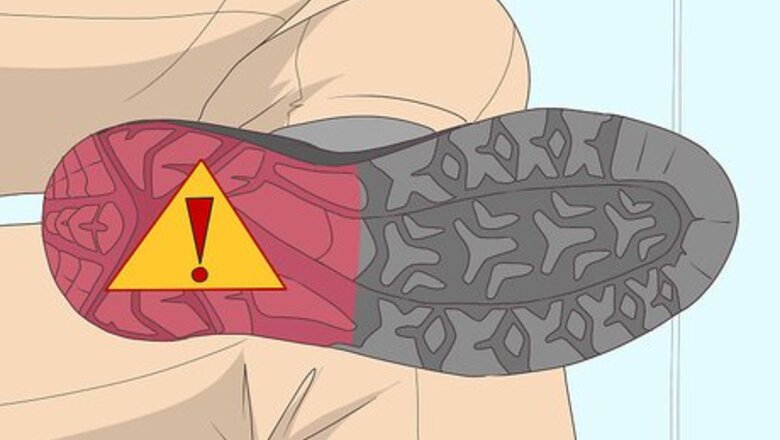
views
X
Research source
However, too much pronation during weight bearing (termed over-pronation) can lead to collapsed arches (flat feet) and bring about issues in your ankles, knees, hips and low back. As such, understanding your degree of pronation is important so you can select the most appropriate shoes and/or corrective shoe inserts.
Detecting Over-Pronation at Home
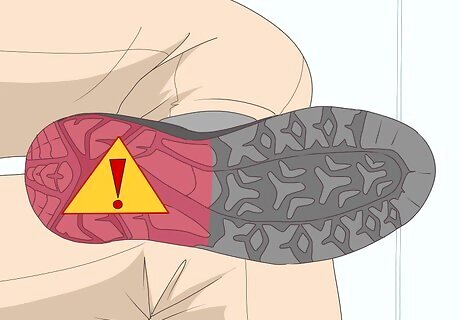
Look at the soles of your shoes. During normal walking (gait), your heel strikes the ground slightly on its outside or lateral edge, which is why the soles of your shoes should be noticeably more worn in that location. If the soles of your shoes appear to be worn directly in the middle of the heel area — or worse, on the inside or medial (middle) edge of the posterior sole — then you likely pronate too much while walking. Wear patterns are likely easiest to notice on old running shoes with rubber soles because they wear down quicker. Keep in mind that wear patterns on the extreme outside (lateral) edge of the posterior sole may indicate a complete lack of normal pronation and too much rigidity in the ankle and/or arch of the foot, which is termed over-supination. People who over-pronate tend not to be exceptionally fast runners because their ankles and feet collapse and don't transmit propulsion force up the leg.
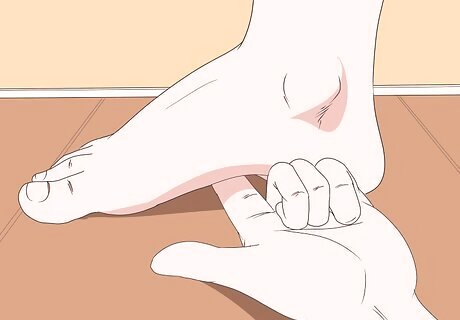
Determine the space underneath your feet. While standing (weight bearing), there should be enough space underneath the inside part of your feet to insert a finger without too much force or discomfort. Thus, ask your partner or friend to help out by trying to stick their forefinger underneath your medial (inside) arches while you stand on firm flooring. If they can do it without difficulty or causing you discomfort, then you likely have normal arches and don't over-pronate (at least while standing). On the other hand, if there's not any space to slide a finger underneath readily, then you likely have flat feet, which is a major indicator and may cause or be caused by over-pronation. It's best to do this type of test in bare feet and while standing on a firm floor, such as wood, tile or linoleum. Having normal looking arches while standing is not always a guarantee of normal amounts of pronation while walking. An overly rigid arch may not collapse, despite the ankle joint rolling in and over-pronating during walking and running, but that's fairly rare. Likewise, having somewhat flat arches when standing still doesn't necessarily mean you over-pronate.
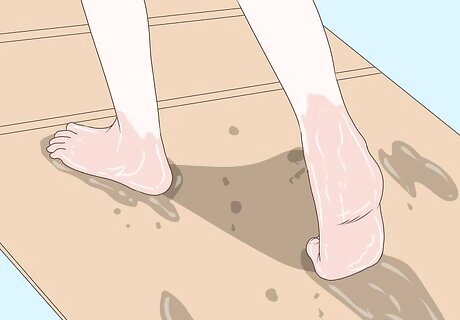
Wet your feet and walk on cardboard. A good objective test to see whether or not you over-pronate and/or have flat feet is the "wet feet" test. Dampen the bottoms of your feet with water and walk across some cardboard, thick paper or any surface that clearly shows your wet footprint. Make sure to get prints of both feet and look at them closely. A foot with a healthy arch and normal amount of pronation will leave a print of the heel, connected to the front forefoot by a strip about 1/2 the width of the foot on the outside of the sole. If you over-pronate, your entire foot will be visualized on the print because the entire underside of your foot contacted the ground while walking, which is abnormal. The way your arch appears on this wet test is a good indication of how your foot pronates, but not a guarantee of over-pronation, because some people with flat feet don't necessarily over-pronate when they walk. Typically, both feet leave the same kind of footprint, but in some cases differences are noticed due to previous foot / ankle injuries or leg length differences.
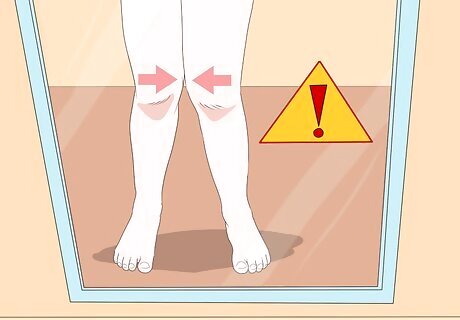
Look in the mirror at your posture. Another indicator of how your ankles and feet are working while weight bearing and walking is to look at your posture (below your waist mainly) while standing in front of a full-length mirror. Change into some shorts and look at your legs, knees and ankles. In general, people with knees that are very close together or touch while standing (called knock knees or genu valgum) are often over-pronators with flat feet because more pressure is placed on the medial part of the foot. As well, look at the thick Achilles tendon that attaches your heel to your calf muscles. It should be straight, but in over-pronators it's almost always crooked and deviates laterally. Over-pronation is sometimes related to genetics that dictate the development of the ankle and foot, but often it's caused by obesity. Over-weight people may have Posterior Tibial Tendon Dysfunction (PTTD). The arch of the foot is, in large part, held up by this tendon, which can wear out when placed under too much force. Your legs should be fairly straight, with at least a few inches between your knees, as you look into a mirror at your posture. People who are "bow-legged" (medically referred to as genu varus), often walk more on the outsides of their feet and tend to over-supinate.
Getting a Medical Assessment

See your family doctor. If you think you pronate too much and believe it's causing pain or other symptoms in your feet, ankles, knees or low back then make an appointment with your physician. Although your doctor is not a foot specialist, she should be familiar enough with normal anatomy and physiology that she can detect abnormalities and make helpful recommendations. She can also better assess what's causing your symptoms. For example, foot, ankle and/or knee pain is often caused by osteoarthritis (the wear and tear type), repetitive trauma, circulatory problems, lack of exercise and obesity, and may have nothing to do with your degree of foot pronation. Your doctor may take foot x-rays, which is great for seeing bone alignment (a collapsing ankle joint can be detected, for example), but not great for seeing the integrity of the ligaments and tendons that form the foot's arch. Your doctor may recommend that you lose weight by changing your diet, which may relieve your symptoms and reduce the degree to which you pronate. If you're pregnant, your doctor may tell you to be patient because the hormones released during pregnancy make ligaments more lax, which can lead to temporary flat feet and over-pronation. Occasionally this can become a permanent condition — if symptoms persist for more that six months postpartum, you should be re-evaluated.
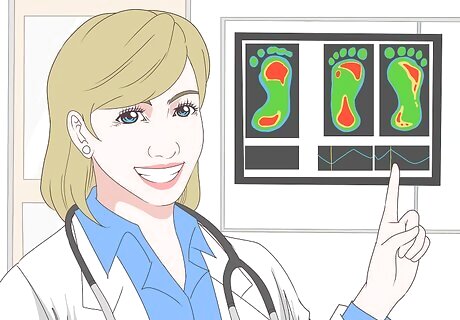
Consult with a podiatrist. A podiatrist is a foot specialist who is more familiar with the normal biomechanics of the feet and the various conditions and diseases that cause abnormal gait (walking and running), including over-pronation and flat feet. A podiatrist will examine your feet, including your arches and ankles, and determine if your degree of pronation is normal or abnormal. A computerized gait analysis is often used by podiatrists to better understand how you walk and to what degree you pronate. The analysis typically involves walking over a sensitive force plate that's connected to a computer. Some doctors may also use thermography (heat sensitive pads) to better understand the biomechanics of your feet while walking. Conditions related to chronic over-pronation include plantar fasciitis, heel spurs, bunions, Achilles tendinitis and shin splints. To correct over-pronation, podiatrists usually recommend custom made orthotics (shoe inserts with strong arch support) or orthopedic shoes that help prevent the ankle from rolling in excessively. Podiatrists are trained for relatively minor foot operations, but more complex or involved surgical procedures are usually done by orthopedic surgeons.

Get a referral to an orthopedic surgeon. If you think you over-pronate (with or without flat feet) and are not getting adequate relief from conservative approaches such as orthotics, supportive shoes and weight loss, then ask your family physician for a referral to an orthopedic surgeon (musculoskeletal surgeon) who specializes in the foot. The orthopedic surgeon may use a CT scan, MRI or diagnostic ultrasound to visualize the soft tissues of your foot to confirm if you pronate too much and then determine the likely causes. This doctor can tell you if you pronate, and present all your options for treatment, which may include corrective surgery. Your doctor will likely not suggest surgery until all other possibilities have been exhausted. Some causes of pronation, such as tarsal coalition (an abnormal fusion of two or more bones around the ankle), are only correctable with surgery. Surgery may also be required to lengthen an overly tight Achilles tendon or to repair an overly lax posterior tibial tendon (the main tendon of the foot's arch) — both causes of over-pronation. Recovery times for surgery vary depending on the procedure (whether bones need to be broken or fused, tendons severed, or ligaments altered), but can last several months.


















Comments
0 comment